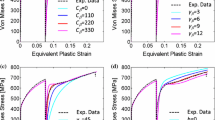Abstract
Based on the upper bound solution of cell models under dynamic or creep loading conditions, the Gurson-Tvergaard-Needleman (GTN) constitutive law of ductile fracture for rate and temperature-dependent materials with isotropic and kinematic hardening has been established. Two additional parameters, which account for the influences of strain rate, inertia and the average distance between voids, have been introduced in the GTN yield criterion. 2D and 3D analysis has been performed for different metals. It can be concluded that the GTN model is a powerful tool for crack growth analysis.
Similar content being viewed by others
Author information
Authors and Affiliations
Rights and permissions
About this article
Cite this article
Hao, S., Brocks, W. The Gurson-Tvergaard-Needleman-model for rate and temperature-dependent materials with isotropic and kinematic hardening. Computational Mechanics 20, 34–40 (1997). https://doi.org/10.1007/s004660050213
Published:
Issue Date:
DOI: https://doi.org/10.1007/s004660050213




